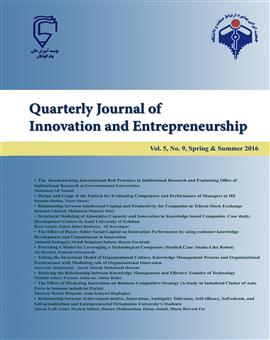بررسی رابطه بین مدیریت دانش و انتقال اثربخش فناوری
الموضوعات :عباس رفیعی 1 , مصطفی جعفری 2 , پیمان اخوان 3
1 - دانشگاه مالک اشتر
2 - دانشگاه علم وصنعت ایران
3 - دانشگاه صنعتی مالک اشتر
الکلمات المفتاحية: انتقال فناوری , مدیریت دانش , فناوری , توانمندی دانشی , اثربخشی,
ملخص المقالة :
..هدف تحقیق شناسایی عوامل دانشی موثر بر طراحی و جذب فناوری در مراکز دانش بنیان و صنایع تولیدی و بررسی تاثیر مدیریت دانش بر هریک از این عوامل و انتقال موفق فناوری می باشد . روش تحقیق ، توصیفی از نوع همبستگی می باشد. در این تحقیق با استفاده از روش تصادفی ساده تعداد 151نفر به عنوان نمونه از بین گروه های علمی وتحقیقی و تعداد 277 نفر نیز از صنایع تولیدی انتخاب شدند. داده های تحقیق از طریق پرسشنامه گردآوری شد. برای روایی سنجی از روایی سازه و تحلیل عاملی تاییدی و برای پایایی سنجی از آلفای کرونباخ استفاده گردید. جهت بررسی روابط بین متغییرهای تحقیق و بررسی فرضیات از مدلسازی معادلات ساختاری به کمک نرو افزار اس پی اس اس و ایموس استفاده شده است . در نتایج تحقیق مشخص گردید رابطه مثبت و معنی داری بین مدیریت دانش و انتقال موفق فناوری وجود دارد ، با این تفاوت که مدیریت دانش تنها درمراکز دانش بنیان ، اثر مستقیم بر انتقال موفق فناوری دارد. همچنین مدیریت دانش از طریق توانمندی دانشی به عنوان یک متغییر میانجیگر ، اثر غیر مستقیم بر انتقال اثر بخش فناوری دارد که میزان تاثیر آن در مراکز دانش بنیان ( 35%) و در صنایع تولیدی ( 77%) می باشد .
Akhavan ,P.and Ramezan ,M. and Yazdi Moghadam ,J.(2013) . Examining The role of ethics in Knowledge Management process.Journal of Knowledge Management –based Innovation in china.vol .5 No.2, pp,129-145
Albino, V., Garavelli, A. C. And Schiuma, G. (1999). Knowledge Transfer And Inter-Firm Relationships In Industrial Districts: The Role Of The Leader Firm. Technovation 19,53-63.
Asghari ,M . and Pakhshanikia , M .(2013) .Technology Transfer in Oil Industry , Si , gnificance and Challenges Original Recearch Article Procedia – Social and Behavioral Sciences 75 ,pp 264-271.
Billiet, J. ,et al. (2003). Cross-cultural equivalence with structural equation modeling. John Wiley and Sons, Hoboken, NJ, pp. 247-264.
Bishop, K., D’este, P. And Neely, A. (2011). Gaining From Interactions With Universities: Multiple Methods For Murturing Absorptive Capacity. Research Policy 40, 30-40.
Bohhn, R . E. (1994). Measuring And Managing Technology Knowledge, Sloan Management Review, Vol. 36, No. 1,pp. 61-73.
Carayannis, E. G., Alexander, J. And Loannidis, A. (2000). Leveraging Knowledge, Learning, And Innovation In Forming Strategic Govermment-University-Industry (Gui) R&D Partnerships In The Us, Germany, And France. Technovation 20, 477-488.
Carolina Lopez-Nicolas*, Angel L.Merono-Cerdan, (2011) Strategic Knowledge Management, Innovation And Performance, International Journal Of Information Management 31, 502-509.
Chen, C.& Huang, J .(2009). Strategic Human Resource And Innovation Performance – The Mediating Role Of Knowledge Management Capcity,Journal Of Buisiness Research,Vol.62,No.1,pp.104-114
Cheung, G. W., & Rensvold, R. B. (2002). Evaluating goodness-of-fit indexes for testing measurement invariance. Structural equation modeling, 9(2), 233-255.
Darroch, J. (2003). Developing A Measure Of Knowledge Management Behaviors And Practices. Journal Of Knowledge Management,Vol. 7,No.5, pp.41-54.
Davenport T, And Prusak L. (1998). Working Knowledge, Hardvard Business School Press, Boston.
Decter, M., Bennett, D. And Leseure, M. (2007). University To Business Technology Transfer- Uk And Usa Comparisons. Technovation 27, 145-155.
Gallivan, M. (2005). Information Technology And Culture, Information And Organization, 15, 295-338.
Gupta, A., & Govindarajan, V. (2000). Knowledge Flows Within Multinational Corporation. Strategic Management Journal,Vol. 21,No.4,pp. 473-496.
Harrington, S. (2005). Corporate Culture, Absorptive Capacity And It Success, Information And Organization, 15, 39-63.
Human,Haidar Ali(2005),Structural equation modeling using lisrel software,Tehran, one publish , samt Issuance,(In Persian)
Horn, J. L., & McArdle, J. J. (1992). A practical and theoretical guide to measurement invariance in aging research. Experimental aging research, Vol.18,No.3,pp. 117-144.
Jonson ,James ,. (1998),culture , freedom, economic growth , World Business ,Vol.33,No..4,pp.332-356
Kodama, T. (2008). The Role Of Intermediation And Absorptive Capacity In Facilitating University-Industry Linkages: An Empirical Study Of Tama In Japan. Research Policy 37, 1224-1240.
Marques , J . P . C ., Caraca , J . M . G . and Diz , H . (2006) . How can university-industry- government interactions change the innovation scenario in potugal? – the case of the University of Coimbra . Technovation 26 , 534-542.
Monavvarian, A. and Aslgari,N. and Akhavan , p. and Ashena,M.(2013).Developing Social Capital for Facilitating Knowledge Management Practices. International Journal of Social Economics. Vol,40.No .9,pp.826-844.
Mu, J., Tang, F. And Maclachlan, D. L. (2010). Absorptive And Disseminative Capacity: Knowledge Transfer In Intra-Organization Networks. Expert Systems With Applications 37, 31-38.
Pertusa-Ortega, E. M., Zaragoza-Saez, P. And Claver-Cortes, E. (2010). Can Formalization, Complexity, And Centralization Influence Knowledge Performance? Journal Of Business Research 63, 310-320.
Ramin mehr, Hamid and Charsetad,Parvaneh(2013), Quantitative Research method using structural equation modeling(Lisrel software),Tehran,Terme issuance, one publish,(In persian)
Reisman, A. (2005). Transfer Of Technologies, A Cross Disciplinary Taxonomy, Omega, 33, 189-202.
Shaojie, A. (2006). The Influence Of Market, Cultural, Environmental Factors On Technology Transfer, Journal Of World Business, 41, 100-111.
Steenkamp, Jan-Benedict EM, and Hans Baumgartner(1998). Assessing measurement invariance in cross-national consumer research. Journal of consumer research.
Stock, G. (2001). Organizational And Strategic Predictors Of Manufacturing Technology Implementation Success, Technovation, 21, 625-636.
Stock, Gregory N, (2000). A Typology Of Project Level Technology Transfer Processes, Journal Of Operations Management 18, 719-737.
Wang, P. (2004). An Integrated Model Of Knowledge Transfer, World Business, 39, 168-182.
Wei-Wen Wu*, (2012). Segmenting Critical Factors For Successful Knowledge Management Implementation Using The Fuzzy Dematel Method, Applied Soft Computing 12, 527-535.
Yuling Wang*, Jianguo Zheng, (2010) . Knowledge- Management Performance Evaluation Based On Triangular Fuzzy Number, Procedia Engineering 7, 38-45.


